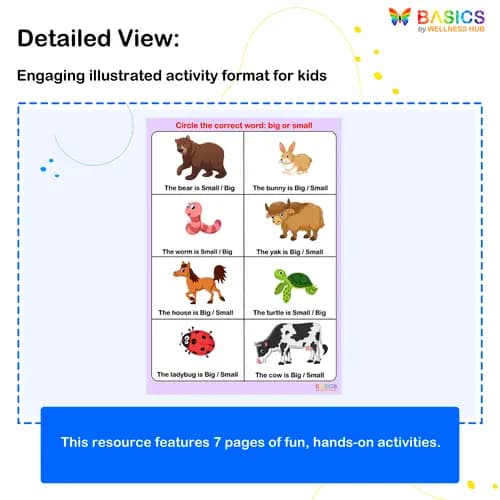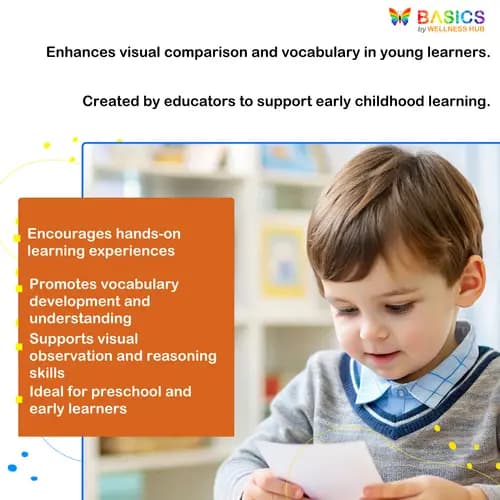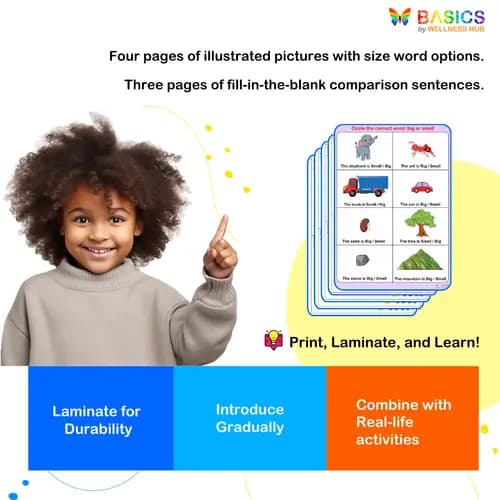





Big and Small Activity Book: Understanding Size Concepts for Kids
₹80
₹160
50% off
0 (0 ratings)
Grade Levels
Pre-K - Kindergarten (Ages 3-6)
Content Overview
Format: Printable PDF | Pages: 7 | Features: Engaging activities to identify and compare sizes.
Categories
Pages from the Resource
This printable PDF helps children learn about size by identifying and comparing objects as big or small. With engaging activities, kids will circle the correct size words and fill in the blanks for paired images. Perfect for preschoolers and early learners to develop vocabulary, reasoning, and writing skills.

Page 1

Page 2
What Users Say
0
0 ratings
5
0+
4
0+
3
0+
2
0+
1
0+
5 Stars
Product is Good to use.
1 year ago
Varsha Parent
Similar Products

Professions Flashcards for Kids – Explore Careers Printable PDF
₹ 80.00
₹ 160.00
50% off
4.6 (54 ratings)
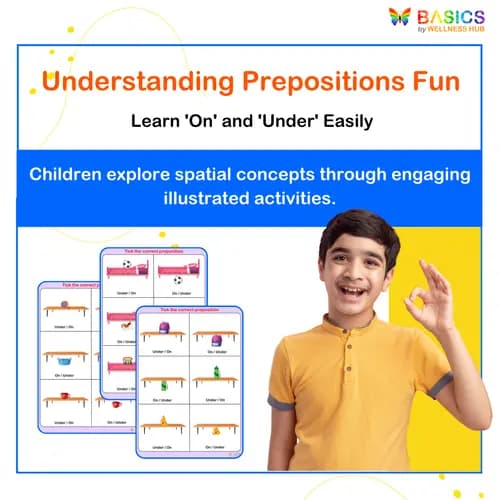
On and Under Prepositions Activity: Printable PDF for Kids
₹ 80.00
₹ 160.00
50% off
4.9 (52 ratings)
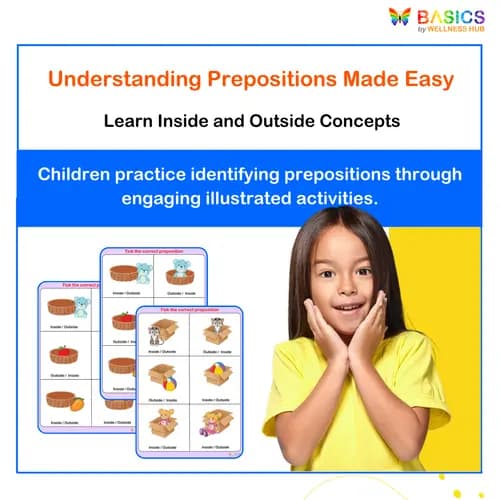
Inside and Outside Prepositions Activity: Printable PDF for Kids
₹ 80.00
₹ 160.00
50% off
4.8 (48 ratings)
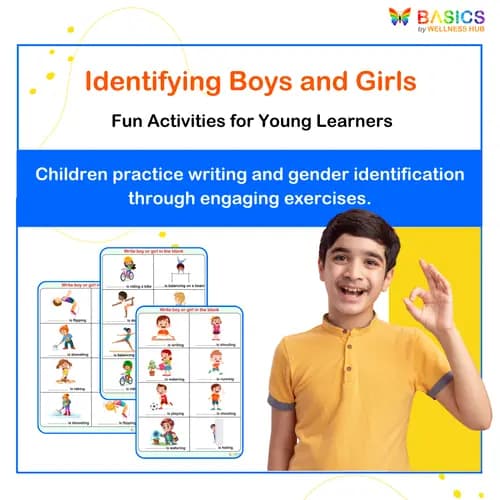
Identifying Boys and Girls: Printable PDF for Observation and Writing
₹ 80.00
₹ 160.00
50% off
4.9 (52 ratings)
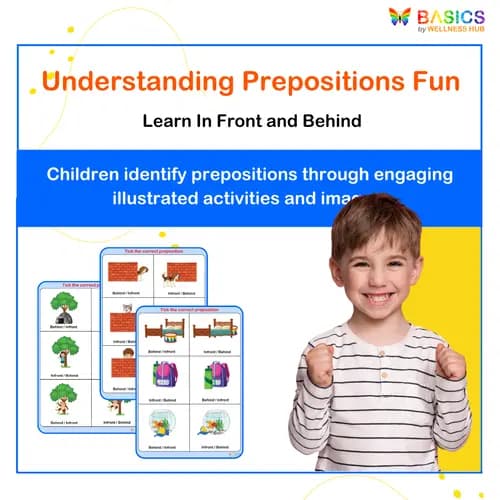
In Front and Behind Prepositions Activity: Printable PDF for Kids
₹ 80.00
₹ 160.00
50% off
4.8 (48 ratings)
About the Product
Introduction
Understanding size concepts is a fundamental skill for early learners, helping them make sense of the world around them. The Big and Small Size Comparison Activity is a printable PDF designed to engage preschool and early elementary children in identifying, comparing, and labeling objects based on size. This resource features a variety of familiar objects and animals, making the learning process relatable and enjoyable.
With 7 pages of interactive activities, children will first circle the correct size word—"Big" or "Small"—for illustrated pictures, reinforcing their understanding of size distinctions. In the second part of the resource, children will fill in the blanks in sentences comparing big and small versions of the same object, further enhancing their vocabulary and reasoning skills. This hands-on approach not only promotes visual comparison but also encourages observation and writing practice, making it an ideal tool for parents, teachers, and therapists working with young learners.
Product Details
- Format: Printable PDF
- Total Pages: 7
- Pages 1-4: 8 illustrated pictures per page (32 total) with circle-the-correct-word activity
- Pages 5-7: 6 sets of big-small image pairs per page (18 total) with fill-in-the-blank comparison sentences
- Pages 1-4: Single objects or animals with two size word options ("Big" / "Small") below each picture
- Pages 5-7: Paired images showing big and small versions of the same object or animal, with two sentences below for filling in the correct size words
- Designed For: Preschool and early elementary learners (ages 3-6)
Activity Breakdown: Image Type:
Educational Benefits
1. Enhances Size Recognition Skills
- Children learn to identify and differentiate between big and small objects, strengthening their understanding of size concepts.
- Promotes visual discrimination as they observe and compare various familiar items.
2. Builds Vocabulary and Language Skills
- Introduces new vocabulary related to size, helping children articulate their thoughts more clearly.
- Encourages sentence formation and usage through fill-in-the-blank activities.
3. Develops Fine Motor Skills
- Circling words and writing in blanks promotes hand-eye coordination and fine motor control.
- Engaging in these activities helps prepare children for more complex writing tasks in the future.
4. Encourages Critical Thinking and Reasoning
- Children practice reasoning skills by determining the correct size of objects based on visual cues.
- Fosters observational skills as they analyze and compare pairs of images.
5. Supports Early Writing Practice
- Fill-in-the-blank sentences provide a structured way for children to practice writing and spelling.
- Encourages confidence in their writing abilities as they complete sentences successfully.
Instructions for Use
Step 1: Print the PDF
- Download and print the Big and Small Size Comparison Activity PDF on standard A4 or Letter-sized paper.
- Consider laminating the pages for durability, especially for repeated use in classrooms or at home.
Step 2: Introduce the Concept of Size
- Before starting the activities, discuss the concepts of big and small with the child.
- Use everyday objects around the house or classroom to illustrate the differences in size.
Step 3: Circle-the-Correct-Word Activity
- Begin with pages 1-4, showing the child each illustrated picture.
- Ask them to look at the picture and circle the correct word—"Big" or "Small"—below each image.
- Encourage them to explain why they chose a particular word for each picture.
Step 4: Fill-in-the-Blank Sentences
- Move on to pages 5-7, where children will fill in the blanks comparing big and small versions of objects.
- Read each sentence together and guide them in determining the correct size word to complete the sentences.
- Offer hints if needed, such as asking them to look at the images for clues.
Step 5: Review and Discuss
- After completing the activities, review the answers together.
- Discuss why certain objects are big or small, reinforcing their understanding of size relationships.
Step 6: Reinforce Learning with Real-Life Examples
- Encourage the child to identify big and small objects in their environment during daily activities.
- Ask questions like, "Can you find something big in the room? What about something small?"
Step 7: Repeat and Reinforce
- Revisit the activities periodically to reinforce learning and build confidence.
- Consider using the resource in small groups for collaborative learning experiences.
Activities Using the Resource
1. Size Scavenger Hunt
Objective: Apply size concepts to real-world objects.
How to Play:
- Set a timer for 5-10 minutes.
- Ask the child to find one big and one small object in the room or outside.
- Have them describe each object and explain why they chose it as big or small.
Skill Development:
- Real-world application of size concepts
- Descriptive language skills
- Observation and categorization
2. Size Comparison Chart
Objective: Create a visual representation of size differences.
How to Play:
- Provide a large sheet of paper and drawing materials.
- Ask the child to draw one big object and one small object.
- Label each drawing with the words "Big" and "Small."
Skill Development:
- Creative expression
- Understanding of visual size differences
- Vocabulary reinforcement
3. Big and Small Storytime
Objective: Enhance storytelling skills using size concepts.
How to Play:
- Read a storybook that features big and small characters or objects.
- Pause and ask the child to identify which characters or items are big or small.
- Encourage them to create their own story using big and small objects.
Skill Development:
- Narrative skills
- Comprehension and engagement
- Imaginative thinking
4. Size Sorting Game
Objective: Develop sorting and categorization skills.
How to Play:
- Gather a variety of objects (toys, kitchen items, etc.).
- Ask the child to sort them into two groups: big and small.
- Discuss their choices and ask them to explain their reasoning.
Skill Development:
- Critical thinking and reasoning
- Classification skills
- Verbal articulation
5. Fill-in-the-Blank Relay
Objective: Reinforce fill-in-the-blank sentence skills through movement.
How to Play:
- Set up a relay race where the child runs to a designated spot to retrieve a sentence card.
- They must fill in the blank with the correct size word and run back to you.
- Repeat with different cards to keep the game dynamic.
Skill Development:
- Active engagement with learning
- Physical coordination and teamwork
- Sentence structure familiarity
6. Size Art Collage
Objective: Encourage creativity while reinforcing size concepts.
How to Play:
- Provide magazines or printed images of various objects.
- Ask the child to cut out pictures of big and small items and create a collage.
- Label each item with "Big" or "Small" and display the collage.
Skill Development:
- Fine motor skills through cutting and pasting
- Visual discrimination and categorization
- Artistic expression and creativity
Frequently Asked Questions
Q1: What age group is this resource designed for?
A1: This resource is specifically designed for preschool and early elementary learners, typically ages 3 to 6. The engaging illustrations and simple activities are tailored to help young children grasp the concepts of big and small in a fun and relatable way. It encourages active participation, making it ideal for both individual and group settings.
Q2: How can I print this PDF for classroom use?
A2: You can print the PDF on standard A4 or Letter-sized paper. For durability, especially if you plan to use the resource repeatedly, consider laminating the pages before cutting them out. This will help protect the pages from wear and tear during classroom activities, ensuring that they last longer and remain in good condition for multiple uses.
Q3: Can this resource be used in group therapy settings?
A3: Yes, this resource is perfect for group therapy settings as it promotes interaction and discussion among children. You can use the activities to facilitate group comparisons and encourage children to express their thoughts on size differences. This collaborative approach not only enhances learning but also builds social skills as children work together.
Q4: Are there any suggestions for differentiating this resource for children with special needs?
A4: Absolutely! You can modify the activities by providing additional visual supports or using tactile objects to help children with sensory needs. For those who may struggle with writing, you can allow them to verbally express their answers or use markers to circle options instead of writing. Adapting the pace of the activities to suit individual needs can also enhance engagement and understanding.
Q5: What is your refund policy if the resource does not meet my expectations?
A5: Wellness Hub offers a satisfaction guarantee for all digital products. If you find that the resource does not meet your needs, please contact our support team within 30 days of purchase for assistance. We will work with you to resolve any issues or provide a refund if necessary, ensuring you feel confident in your purchase.
Q6: How can I get support if I have questions about using the resource?
A6: If you have any questions or need support regarding the resource, you can reach out to our customer service team via the contact form on our website. We are committed to ensuring you have a positive experience and will respond promptly to assist you with your inquiries. Our team is knowledgeable and ready to help you make the most of your purchase.
Q7: What types of resources does Wellness Hub offer?
A7: Wellness Hub provides a wide range of expert-led therapy and developmental support resources, including flashcards, worksheets, and visual schedules. These resources are designed to assist parents and caregivers in continuing progress at home. Additionally, the platform offers services like speech and language therapy, occupational therapy, and mental health counseling, all tailored to meet individual needs.
Q8: Is there a bulk licensing option available for schools?
A8: Yes, Wellness Hub offers bulk licensing options for schools and educational institutions. This allows multiple users to access the resources simultaneously, making it a cost-effective solution for classrooms. If you are interested in bulk purchasing, please contact our sales team for more information on pricing and availability.
Q9: How quickly can I access the resource after purchasing?
A9: Once you complete your purchase, you will receive an email with a download link to access the PDF resource immediately. This ensures that you can start using the materials right away without any delays. If you encounter any issues with downloading, our support team is available to assist you.
Q10: Are the resources accessible for children with different learning needs?
A10: Yes, Wellness Hub is dedicated to making its resources accessible for children with various learning needs. The activities are designed to be engaging and adaptable, allowing for modifications based on individual requirements. We encourage caregivers and educators to tailor the activities to best suit the learning styles and abilities of the children they support.
Usage Rights and Restrictions
Allowed Usage:
- Personal use by parents, teachers, and therapists.
- Printable for classroom, home, or therapy settings.
- Can be used in group or one-on-one learning sessions.
Not Allowed:
- Reselling, redistributing, or modifying the resource for commercial use.
- Sharing publicly (e.g., on blogs, social media, or websites) without permission.
- Uploading the file to public sharing platforms.
If you need a bulk license for schools or therapy centers, please contact us.
Conclusion
The Big and Small Size Comparison Activity is a highly effective resource for helping young learners grasp essential size concepts through engaging and interactive activities. With its clear illustrations and simple instructions, this printable PDF is perfect for preschool and early elementary children, making learning about size both fun and relatable.
This resource is ideal for use at home, in classrooms, or during therapy sessions, providing opportunities for children to practice identifying, comparing, and labeling objects as big or small. By fostering critical thinking, vocabulary development, and fine motor skills, it equips children with foundational knowledge that will serve them well in their educational journey. Download this resource today and empower your child to explore the world of size with confidence!
